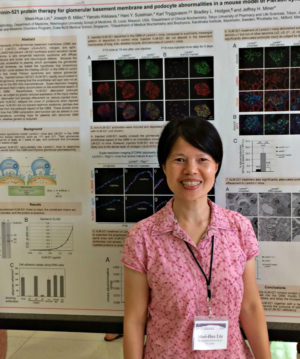An image from a manuscript by Meei-Hua Lin, PhD, Division of Nephrology, was chosen to grace the first issue of JASN’s new cover format. Dr. Lin is a Senior Scientist in the laboratory of Jeffrey Miner, PhD, Professor of Medicine.
The new cover format, debuting on the May 2018 issue, displays a detailed table of contents accompanied by an “eye-catching” sidebar image. The featured image is meant to draw the viewer’s attention to high impact work, while not telling the full story on the cover. A more complete version of the figure, including a legend, shows at the top of the first masthead page.
The image chosen for the cover of JASN’s May issue is a cropped figure from Dr. Lin’s article titled Laminin-521 Protein Therapy for Glomerular Basement Membrane and Podocyte Abnormalities in a Model of Pierson Syndrome published in the issue. Authors include Meei-Hua Lin, Joseph B. Miller, Yamato Kikkawa, Hani Y. Suleiman, Karl Tryggvason, Bradley L. Hodges, and Jeffrey H. Miner.
Pierson syndrome is a rare congenital nephrotic syndrome with diffuse mesangial sclerosis and eye and neurologic abnormalities. It is caused by mutations in the LAMB2 gene that encodes laminin b2, a component of the glomerular basement membrane’s (GBM) laminin a5b2g1 (LM-521) heterotrimer.
Intravenous protein therapy has been effective in mouse models of certain basement membrane protein-associated diseases. In an attempt to restore missing LM-521, Lin et. al. injected human LM-521 into Lamb2 mutant mice that model Pierson syndrome. The protein accumulated in the endothelial aspect of the GBM and reduced proteinuria until 3 weeks of age, after which nephrotic syndrome developed. The cover image shows immunofluorescent staining of hLM-521 incorporated into the GBM 20 days after the last injection (Figure 2C in the manuscript).

Dr. Lin pictured here with a recent poster presentation.
“I am very excited about this work!” says Dr. Lin. “It’s great to be participating in the protein therapy study using the mouse model of Pierson syndrome. With this new approach, we found that injected laminin trimers as large as 800 kDa specifically deposited to the GBM in a correct orientation and stayed there for at least 20 days.”
Lin is encouraged by the results. “Although the protein treatment delayed the increase of proteinuria, but did not prevent the progression to nephrotic syndrome, this study opens a new avenue for therapy for renal defects caused by abnormalities in basement membrane proteins.”
Also in the May issue of JASN (in the Up Front Matters section), in an editorial by Dr. Alda Tufro, Department of Pediatrics and Cell and Molecular Physiology at Yale University, who discusses GBM repair and Lin’s exciting research.
Congratulations to the research team for such stunning research – and images!